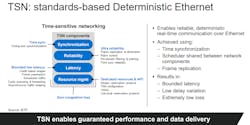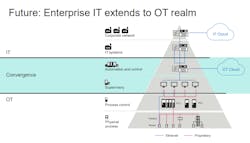Ethernet Switch Chips Connect Factories of the Future with TSN
This article is part of the TechXchange: Time for Time-Sensitive Networking. Also check out more of coverage of Electronica 2022.
A new series of switch chips rolled out by Marvell brings time-sensitive networking (TSN) to factory floors, where every second is critical to keeping robots and industrial automation systems running smoothly.
The networking chip giant said the new Prestera DX1500 series incorporates up to 54 ports with speeds of 10 MB/s to 10 GB/s, while bringing the ruggedness and reliability required to tough it out in industrial systems.
While it lacks the performance of its switch chips for the sprawling networks in cloud data centers, it’s well-suited for deployment on factories, power utilities, and other critical infrastructure where latency, timing, reliability, and redundancy take precedence over bandwidth. Transferring data where it needs to go—when it needs to get there—can mean the difference between a production line operating as intended or crashing.
Today, factory floors are connected with a web of industrial networking buses and protocols that support the precision timing and predictable latency required by “deterministic” networks. Using proprietary technologies instead of Ethernet means all robots, programmable logic controllers, and other operational technology (OT) on a factory floor stay unplugged from the servers and storage that comprise a company’s IT footprint.
Smooth Operation
To solve this, Marvell said it specifically designed its new family of switch chips to suit a new generation of industrial networks that can keep the digital factories of the future running smoothly. The DX1500 switch chips run TSN, a set of standards that covers requirements for latency and timing in OT networks whereby robots and other heavy machinery equipped with sensors can communicate using Ethernet (Fig. 1).
Flexibility is another important facet of the new switch family, according to the company, as it supports configurations ranging from eight up to 54 ports. The chips are designed to be paired with Marvell’s new Alaska E1781 series of 10/100/1000Base-T octal-port copper PHYs.
Marvell aims to supply the switch chips to the likes of traditional industrial equipment makers like Emerson, Honeywell, Schneider Electric, and Siemens, as well as Cisco and other purveyors of server networking gear.
By attaching the new switch to industrial control systems, the DX5100 acts as a bridge between IT and OT networks. TSN gives priority to packets of data used to control robots and other equipment on a factory floor, while opening the door for virtually any type of data to share the same network. According to Marvell, this enables companies to tap into the digital transformation unfolding outside the factory’s walls (Fig. 2).
The Prestera DX1500 integrates the CPU and switch—and the Ethernet PHY in the case of the eight-port switch silicon—in a single chip to reduce system power and complexity plus save space on a PCB.
Anna Ahrens, senior manufacturing technology analyst at Omdia, said that Gigabit Ethernet is rapidly becoming the backbone of manufacturing and other heavy industries, keeping everything on factory floors or power plants connected in real time. “Real-time determinism and time-sensitive networking technology, however, remain important requirements and not features that are historically part of Ethernet.”
Built into the chips is Marvell’s TrackIQ technology that’s specifically designed to help get congestion under control in industrial networks. To help keep the network links in between servers from getting clogged, special-purpose software is used to amass telemetry data about traffic traveling on the network and identify instances where data is delayed. Like a traffic cop, the software steps in to automatically fix any problems.
Furthermore, the switches contain Arm CPU cores that help to collect the data used by companies to keep networks running smoothly. They also can serve as the system host for an on-chip embedded Network Operating System (NOS).
For redundancy, the new switch chips support both Parallel Redundancy Protocol (PRP) and Highly Available Seamless Redundancy (HSR), which support failover in the event of a failure in the network.
Security Measures
Not only are factory floors and other critical infrastructure industries such as electric utilities, railways, and power plants characterized by harsh physical conditions, but they’re also increasingly at risk from hackers as well as malicious software. An additional complication is the location of some industrial networking equipment at the edge, which puts it at a higher risk of physical tampering or security breaches, said Marvell.
To better protect network hardware and software from evolving security threats, the Prestera DX5100 (which with the new Alaska PHYs are currently sampling) supports secure boot so that any untrusted software will not execute on the system. The switches also use MACsec to secure the links between switches in the industrial networks by running cryptography on the data traveling through all of the switch’s ports.
The switches are ruggedized, with the ability to tolerate system temperatures of −40 to +85°C. This improves their reliability in harsh environments, granting the devices an operating lifetime of at least 10 years, said Marvell.
Read more articles in the TechXchange: Time for Time-Sensitive Networking. Also check out more of coverage of Electronica 2022.
About the Author
James Morra
Senior Editor
James Morra is the senior editor for Electronic Design, covering the semiconductor industry and new technology trends, with a focus on power electronics and power management. He also reports on the business behind electrical engineering, including the electronics supply chain. He joined Electronic Design in 2015 and is based in Chicago, Illinois.



